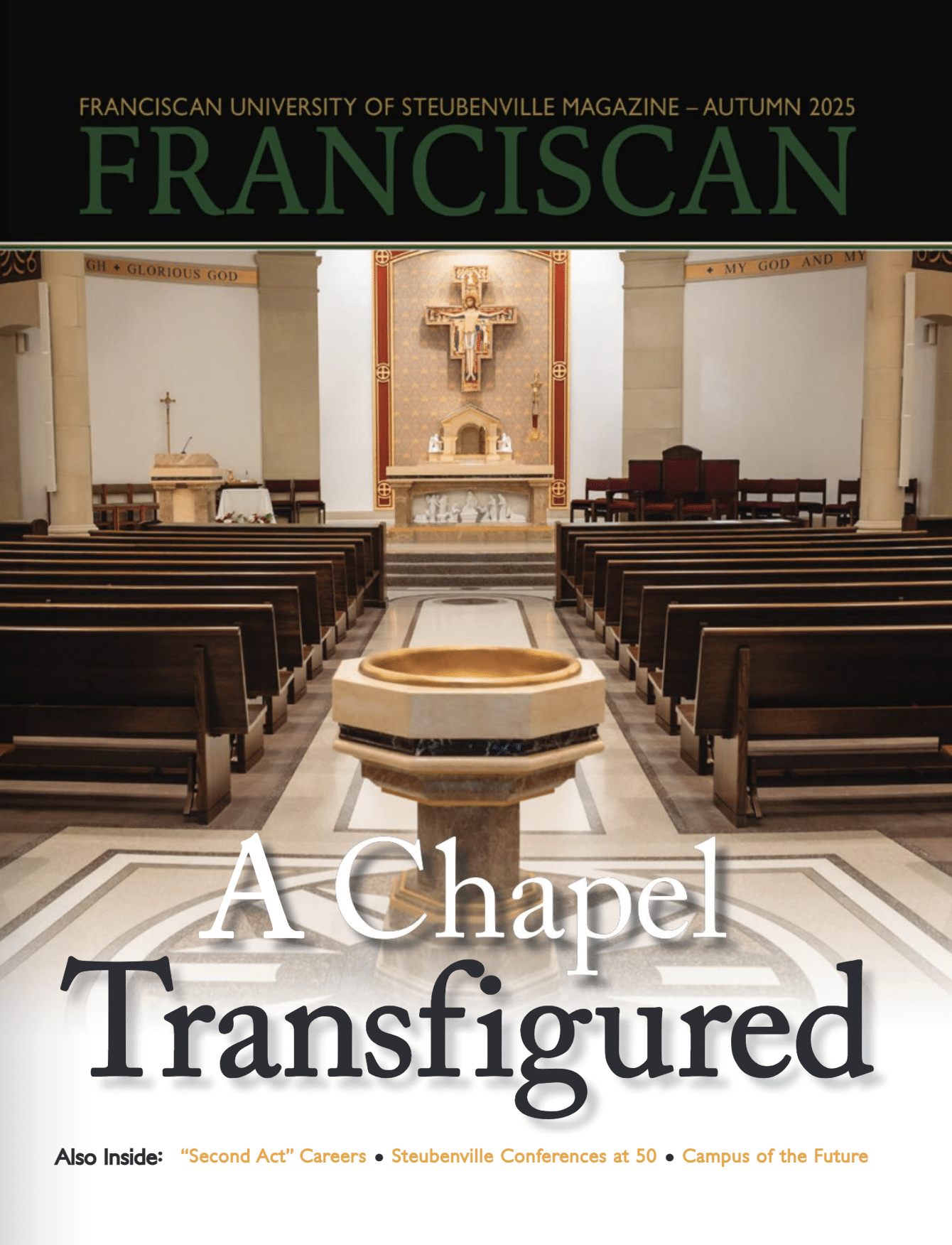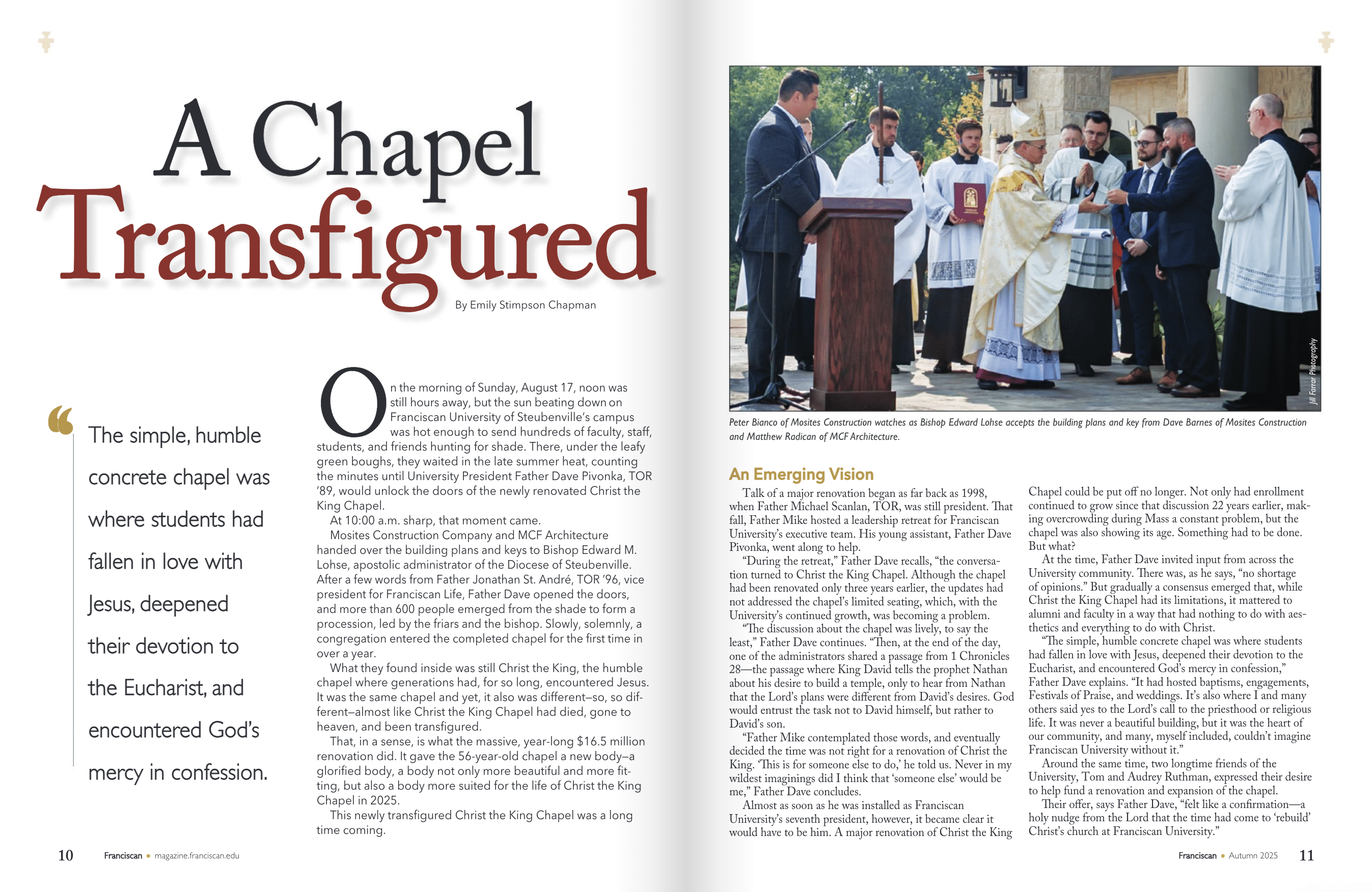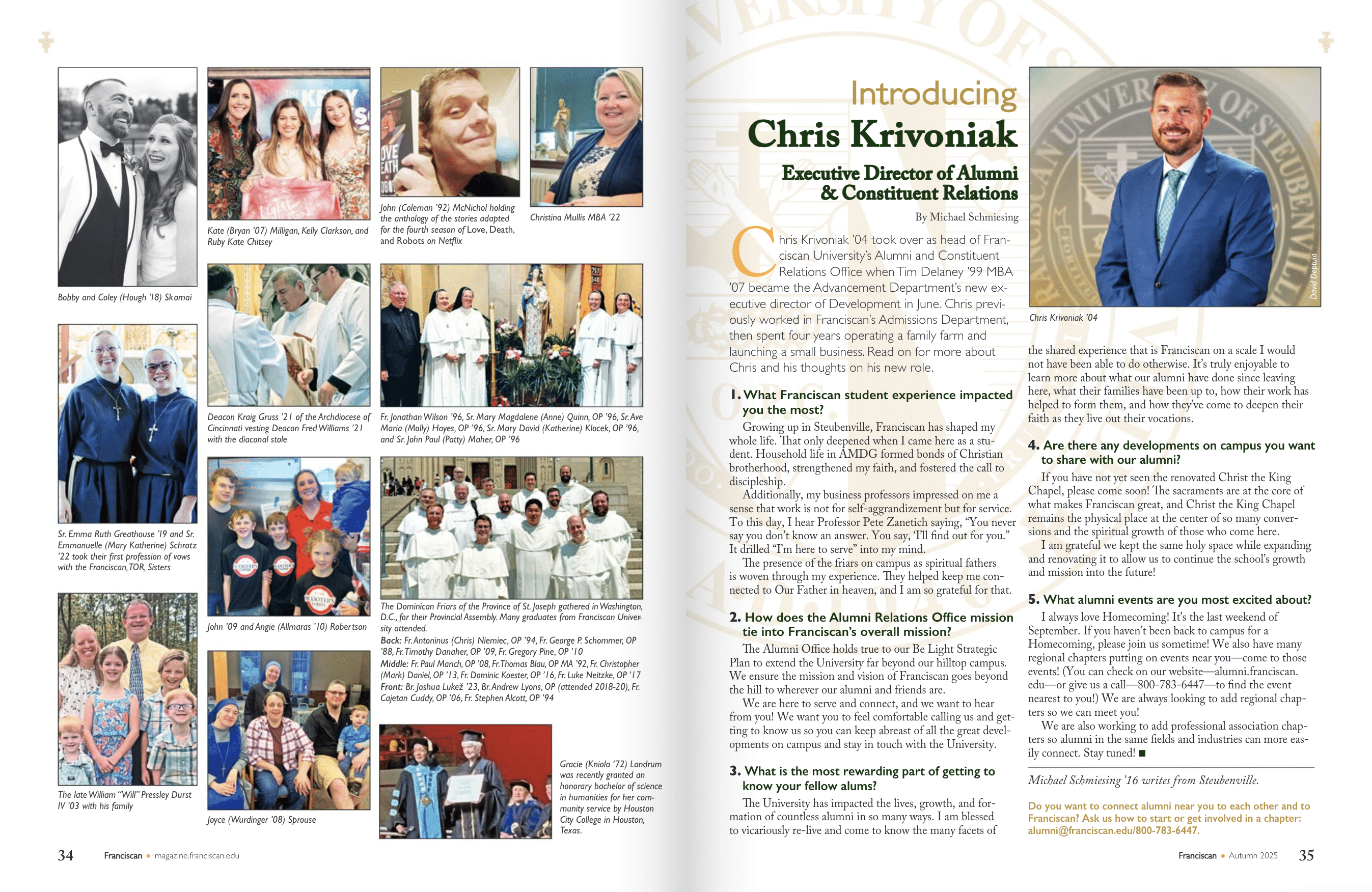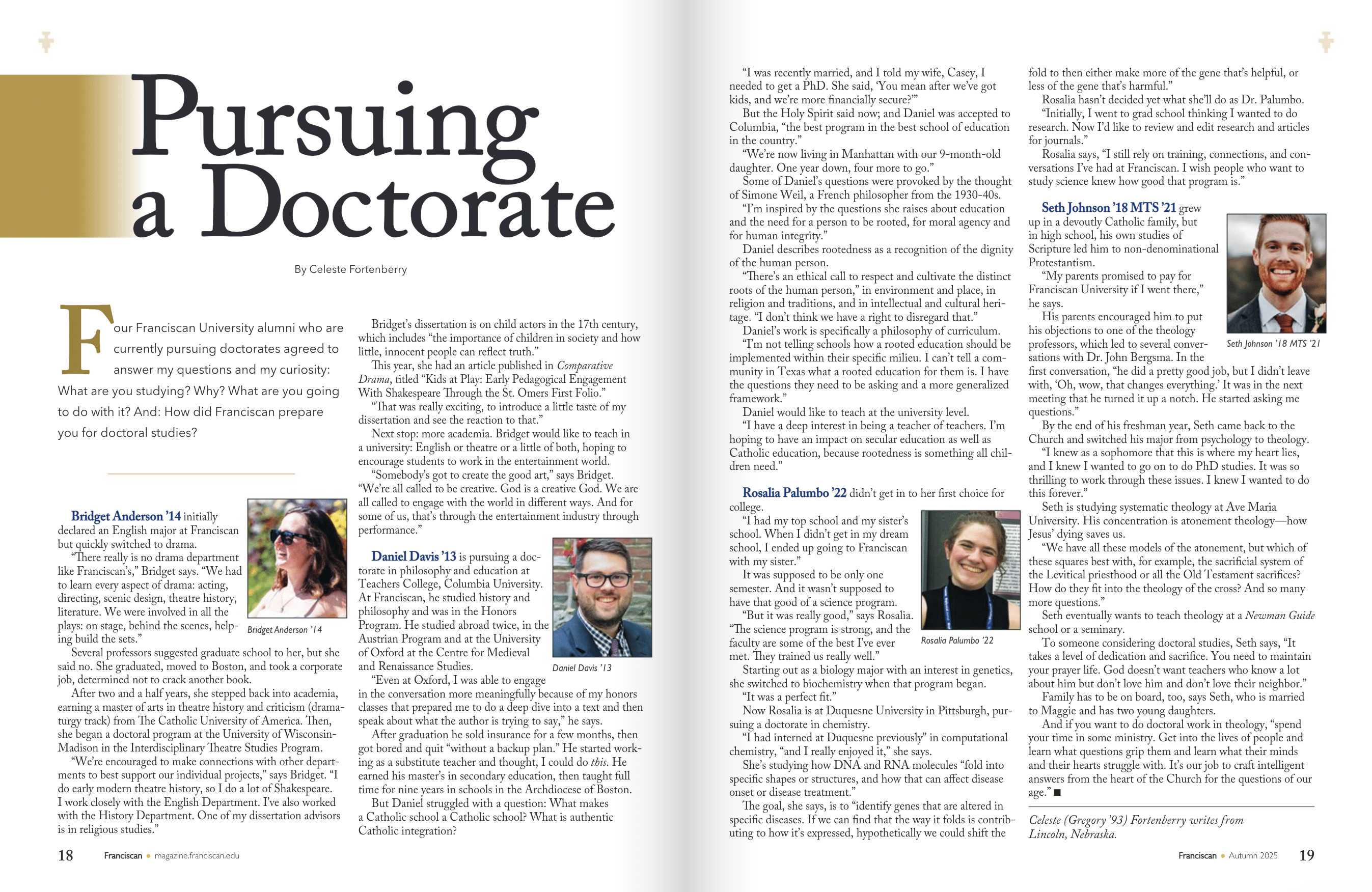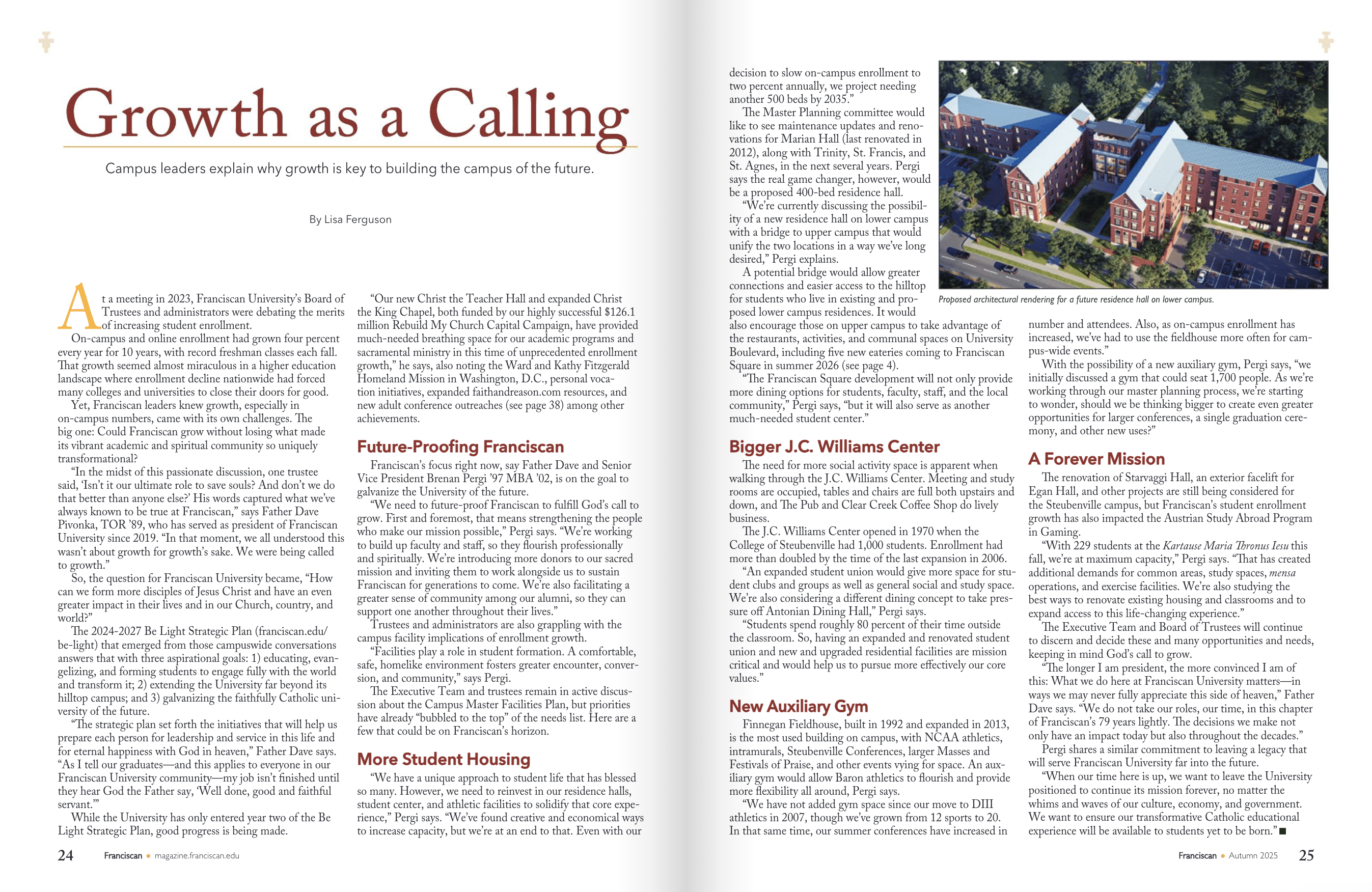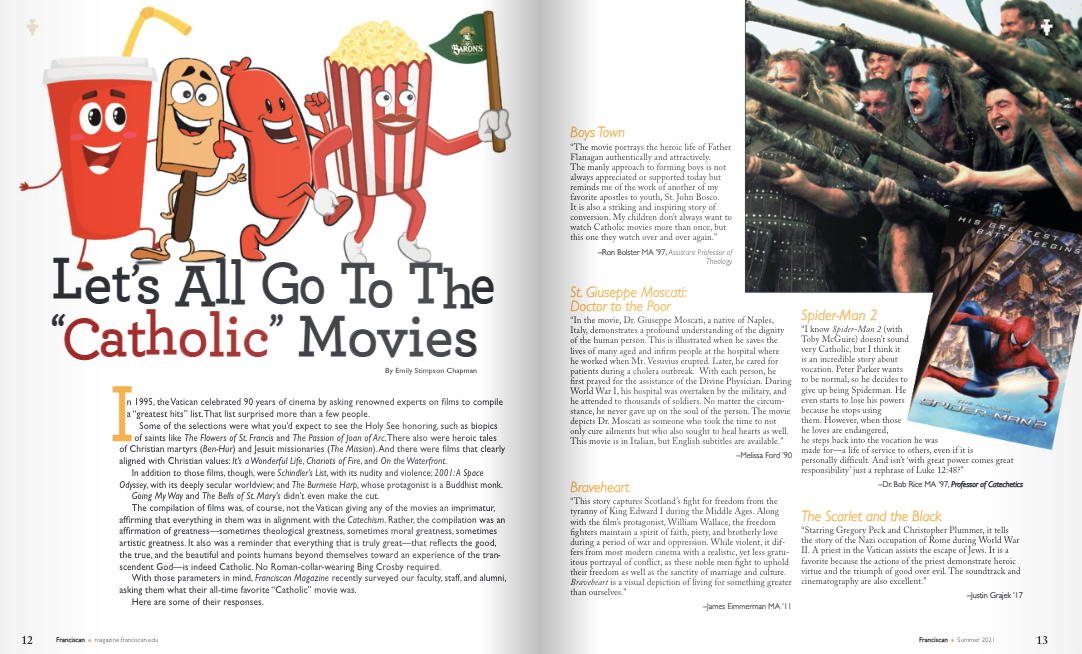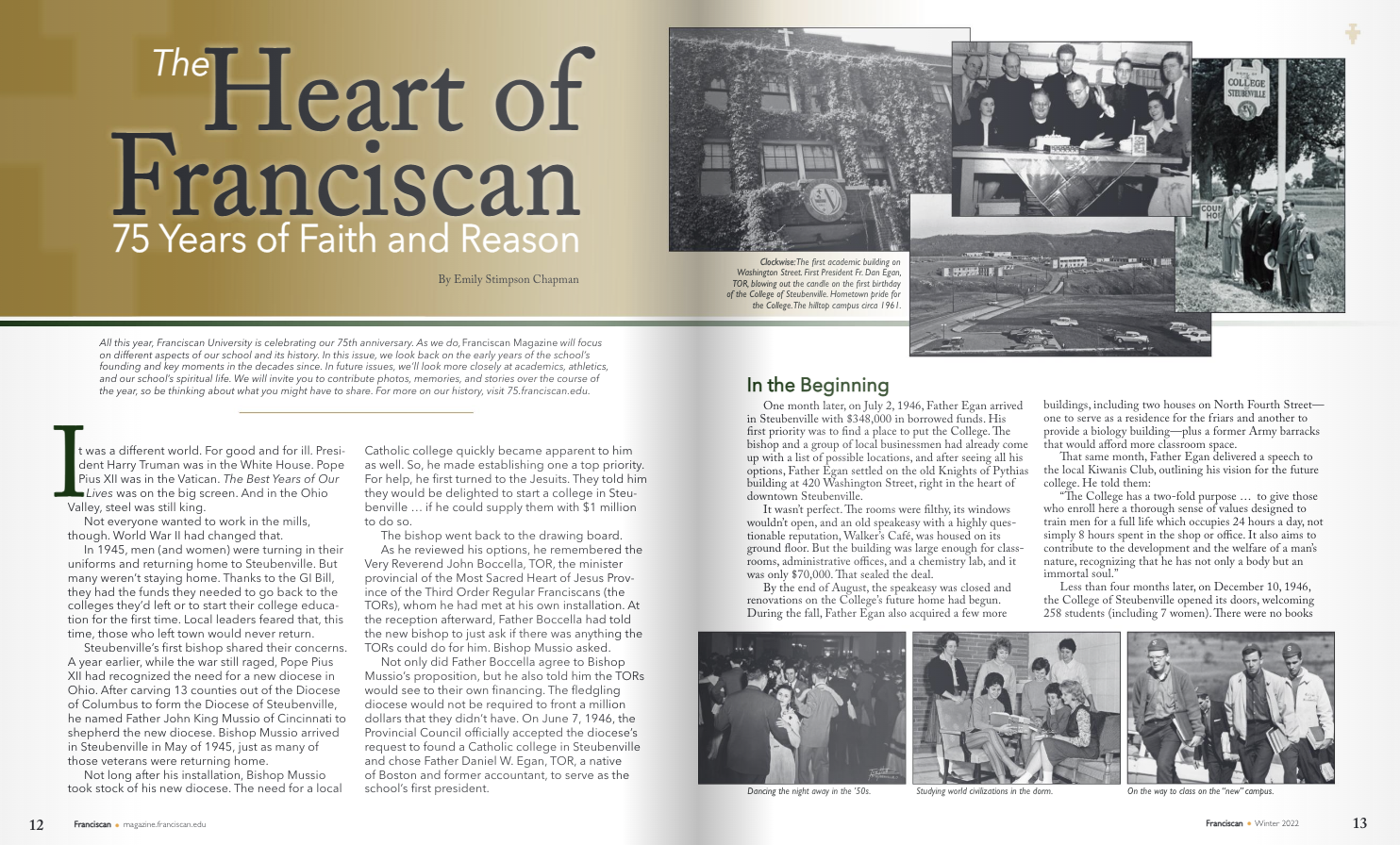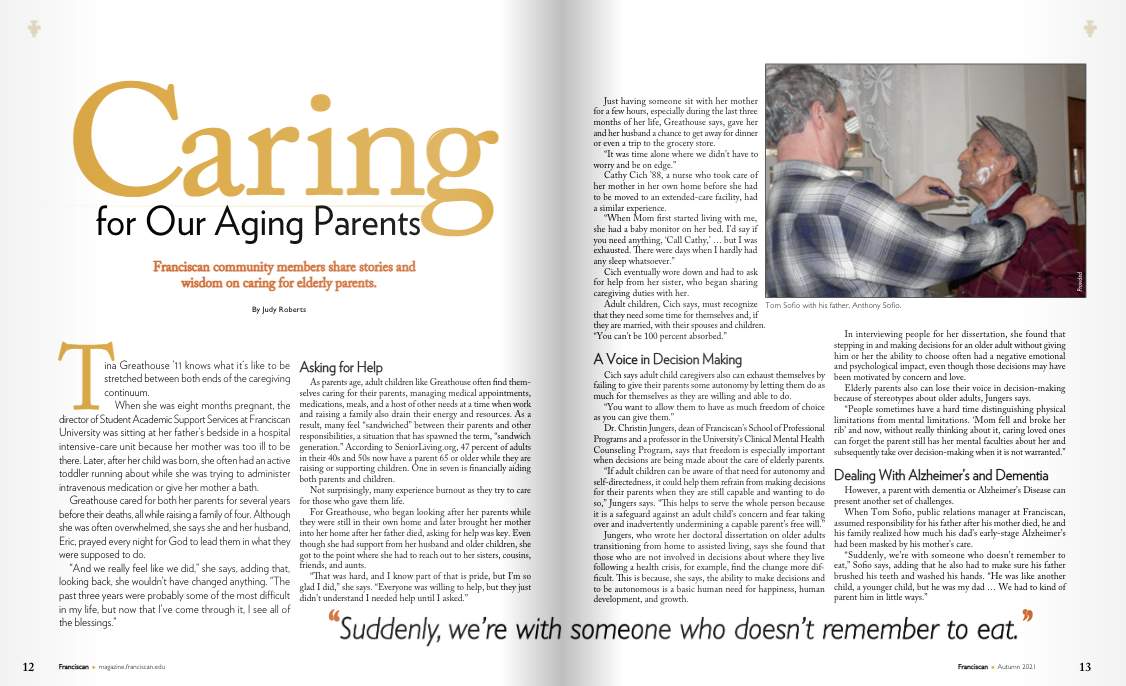On the morning of Sunday, August 17, noon was still hours away, but the sun beating down on Franciscan University of Steubenville’s campus was hot enough to send hundreds of faculty, staff, students, and friends hunting for shade. There, under the leafy green boughs, they waited in the late summer heat, counting the minutes until University President Father Dave Pivonka, TOR ’89, would unlock the doors of the newly renovated Christ the King Chapel.

At 10:00 a.m. sharp, that moment came.
Mosites Construction Company and MCF Architecture handed over the building plans and keys to Bishop Edward M. Lohse, apostolic administrator of the Diocese of Steubenville. After a few words from Father Jonathan St. André, TOR ’96, vice president for Franciscan Life, Father Dave opened the doors, and more than 600 people emerged from the shade to form a procession, led by the friars and the bishop. Slowly, solemnly, a congregation entered the completed chapel for the first time in over a year.
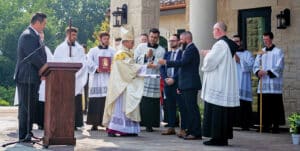 What they found inside was still Christ the King, the humble chapel where generations had, for so long, encountered Jesus. It was the same chapel and yet, it also was different—so, so different—almost like Christ the King Chapel had died, gone to heaven, and been transfigured.
What they found inside was still Christ the King, the humble chapel where generations had, for so long, encountered Jesus. It was the same chapel and yet, it also was different—so, so different—almost like Christ the King Chapel had died, gone to heaven, and been transfigured.
That, in a sense, is what the massive, year-long $16.5 million renovation did. It gave the 56-year-old chapel a new body—a glorified body, a body not only more beautiful and more fitting, but also a body more suited for the life of Christ the King Chapel in 2025.
This newly transfigured Christ the King Chapel was a long time coming.
An Emerging Vision
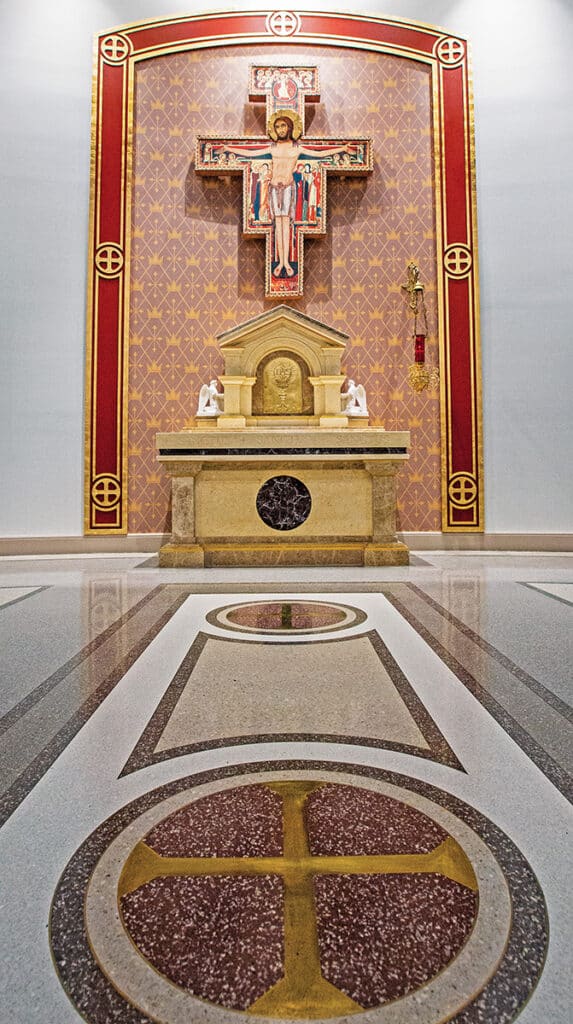 Talk of a major renovation began as far back as 1998, when Father Michael Scanlan, TOR, was still president. That fall, Father Mike hosted a leadership retreat for Franciscan University’s executive team. His young assistant, Father Dave Pivonka, went along to help.
Talk of a major renovation began as far back as 1998, when Father Michael Scanlan, TOR, was still president. That fall, Father Mike hosted a leadership retreat for Franciscan University’s executive team. His young assistant, Father Dave Pivonka, went along to help.
“During the retreat,” Father Dave recalls, “the conversation turned to Christ the King Chapel. Although the chapel had been renovated only three years earlier, the updates had not addressed the chapel’s limited seating, which, with the University’s continued growth, was becoming a problem.
“The discussion about the chapel was lively, to say the least,” Father Dave continues. “Then, at the end of the day, one of the administrators shared a passage from 1 Chronicles 28—the passage where King David tells the prophet Nathan about his desire to build a temple, only to hear from Nathan that the Lord’s plans were different from David’s desires. God would entrust the task not to David himself, but rather to David’s son.
“Father Mike contemplated those words, and eventually decided the time was not right for a renovation of Christ the King. ‘This is for someone else to do,’ he told us. Never in my wildest imaginings did I think that ‘someone else’ would be me,” Father Dave concludes.
Almost as soon as he was installed as Franciscan University’s seventh president, however, it became clear it would have to be him. A major renovation of Christ the King Chapel could be put off no longer. Not only had enrollment continued to grow since that discussion 22 years earlier, making overcrowding during Mass a constant problem, but the chapel was also showing its age. Something had to be done. But what?
At the time, Father Dave invited input from across the University community. There was, as he says, “no shortage of opinions.” But gradually a consensus emerged that, while Christ the King Chapel had its limitations, it mattered to alumni and faculty in a way that had nothing to do with aesthetics and everything to do with Christ.
“The simple, humble concrete chapel was where students had fallen in love with Jesus, deepened their devotion to the Eucharist, and encountered God’s mercy in confession,” Father Dave explains. “It had hosted baptisms, engagements, Festivals of Praise, and weddings. It’s also where I and many others said yes to the Lord’s call to the priesthood or religious life. It was never a beautiful building, but it was the heart of our community, and many, myself included, couldn’t imagine Franciscan University without it.”
Around the same time, two longtime friends of the University, Tom and Audrey Ruthman, expressed their desire to help fund a renovation and expansion of the chapel.
Their offer, says Father Dave, “felt like a confirmation—a holy nudge from the Lord that the time had come to ‘rebuild’ Christ’s church at Franciscan University.”
Practical Planning
That rebuilding began in May 2024, as soon as the school year ended. But before that, months of conversation and then more months of planning took place. Some of the planning was practical.
“We knew the chapel—which was originally built in 1969 for a student body and campus community only one-third the size of today’s—had to be larger,” recalls Father Jonathan, who acted as a liaison between the many committees and parties involved in the renovation. “We didn’t want it to lose the intimate feel of a chapel, but it had to better accommodate our growing University.”
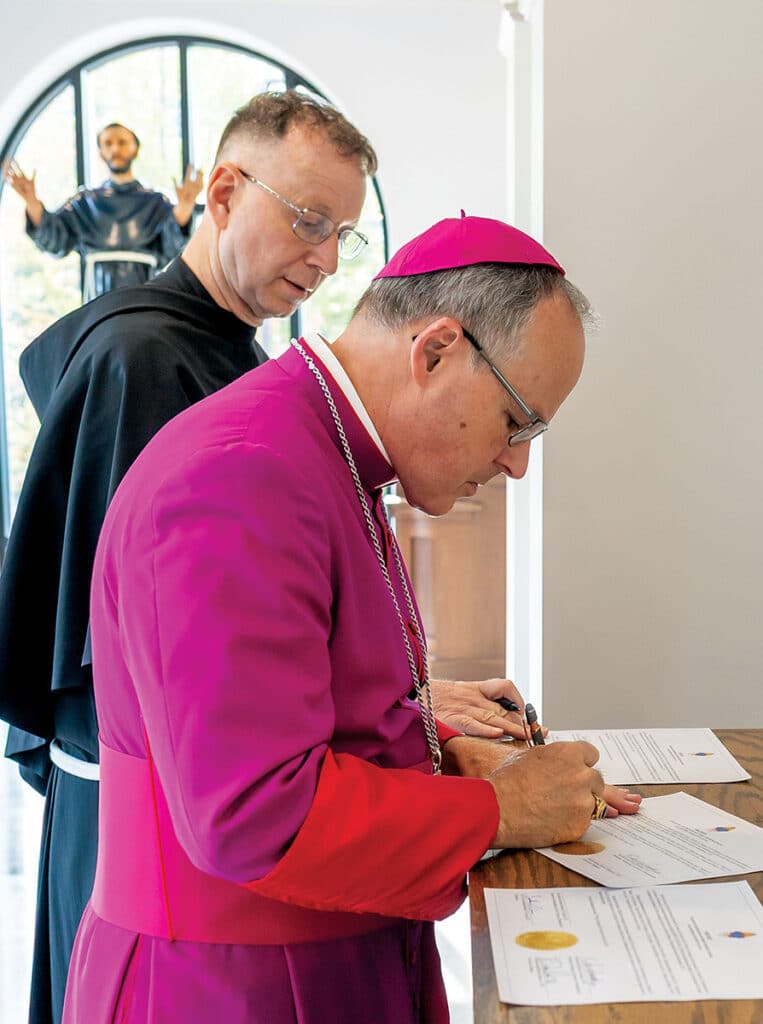 Another practical aspect the University planning committee had to consider was reconfiguring the space to better accommodate the many activities that take place within the chapel, helping it to function more effectively as the center of the campus’ sacramental ministry.
Another practical aspect the University planning committee had to consider was reconfiguring the space to better accommodate the many activities that take place within the chapel, helping it to function more effectively as the center of the campus’ sacramental ministry.
To address the first problem, the University decided to add two “wings” to the former chapel, seamlessly expanding the space with the help of a series of grand Romanesque columns. This expansion increased the seating capacity to 590 people, with room to add up to 100 more seats when necessary, more than doubling the previous seating capacity of 325.
The second problem was solved with the help of MCF Architecture. The Pittsburgh-based design firm helped the University find the space within both the expansion and existing space for a larger vestry and sacristy, two practice rooms for music ministry teams, and an audio-visual room that could manage the audio and lighting needs for every liturgy and service. They also carved out a nursing room, at the back of the nave, to accommodate mothers and the littlest worshippers at every Mass, as well as expanded and relocated the restrooms to a more appropriate space within the chapel.
The primary concerns of the chapel planning committee, however, weren’t practical; they were catechetical.
“Our greatest hope for the chapel was that it would offer all who entered a beautiful and profound catechesis,” says Father Dave. “That was the word we kept coming back to: catechesis. We wanted the very stones of our chapel to proclaim the kerygma, teach the faith, and celebrate the legacy of St. Francis of Assisi.”
That catechesis is what worshippers at the August 17 Solemn Blessing of Christ the King Chapel encountered before they even walked through chapel’s new doors.
Architectural Catechesis
In the newly renovated Christ the King Chapel, the catechesis starts with the chapel exterior and its new outer walls, built, like so many buildings in Assisi, of limestone. There, at the very front, where simple doors once welcomed visitors inside, three great arches now proclaim the majesty of what lies within.
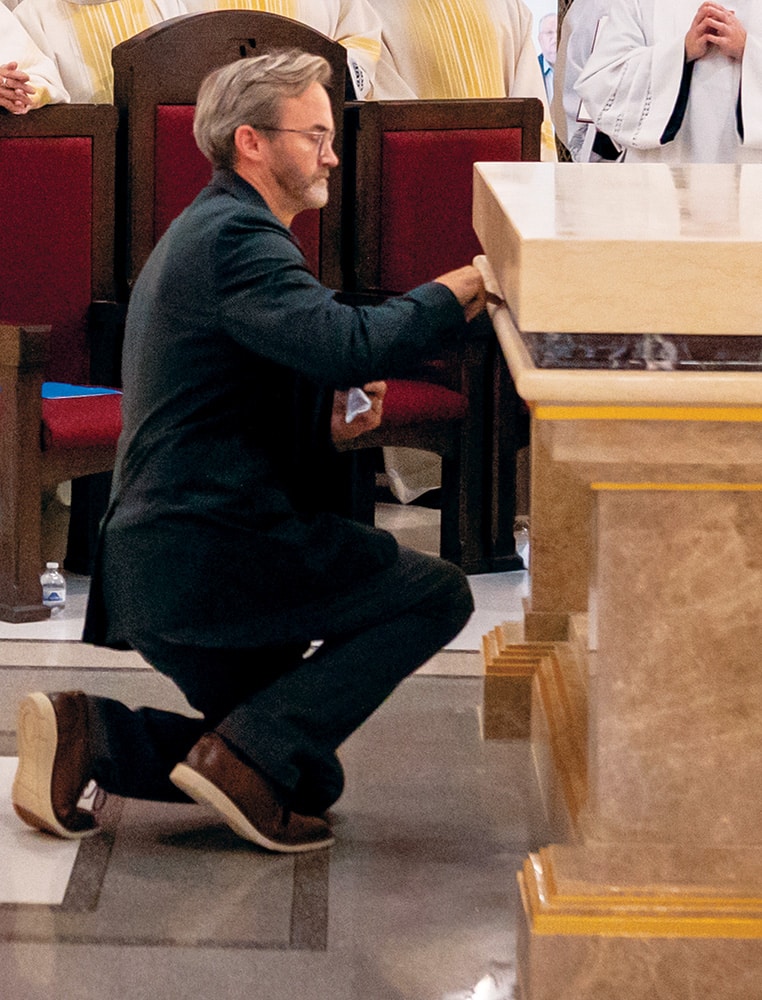 These arches, Father Jonathan explains, “echo the words of Peter when he glimpsed the majesty of Christ at the Transfiguration: ‘Lord, it is well that we are here; if you wish, I will make three booths here, one for you and one for Moses and one for Elijah’ (Matt. 17:4). The arches announce that, inside the chapel, everyone who seeks will find the Law (Moses), the prophets (Elijah), and Jesus Christ, the Lord himself.”
These arches, Father Jonathan explains, “echo the words of Peter when he glimpsed the majesty of Christ at the Transfiguration: ‘Lord, it is well that we are here; if you wish, I will make three booths here, one for you and one for Moses and one for Elijah’ (Matt. 17:4). The arches announce that, inside the chapel, everyone who seeks will find the Law (Moses), the prophets (Elijah), and Jesus Christ, the Lord himself.”
Once worshipers pass through the doors into the chapel narthex, the catechesis continues with a stunning image of Christ the King. Designed and painted by Fine Arts Instructor Amber (Pitts ’17) Knorr, with the help of two of her Franciscan University students, Christ stands in the foreground of the mural, with the monstrance behind him, signifying his enthronement in the Eucharist. An image of the Sacred Heart, burning with love for the Church, is visible on Christ’s garments, while grape vines and sheaves of wheat surround that heart.
“It’s meant as a reminder that we encounter Christ’s heart most intimately in the Eucharist,” explains Knorr.
Below the mural, embedded in the poured terrazzo floors is a large Tau cross, the symbol once used by St. Francis when he signed his name.
According to Father Jonathan, “Francis included the Tau as a reminder of God’s call to ongoing conversion. We decided to include it here not only as a sign of the University’s Franciscan roots but also because we wanted the Tau to offer the same reminder of ongoing conversion to all who enter the chapel.”
Storied Windows
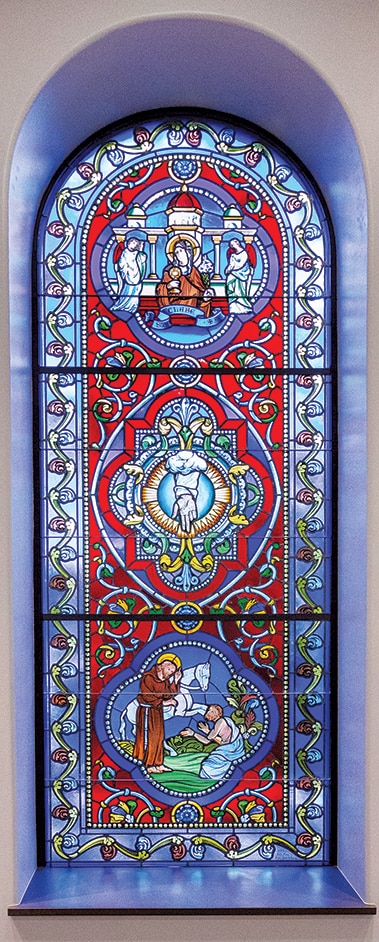 On the eastern-most wall, light pours through four massive stained-glass windows, which offer a catechesis all their own. Like nearly all the stained glass in the renovated chapel, these windows are the work of Franciscan alumnus Carl Fougerousse ’98, who teaches fine arts at Franciscan’s study abroad program in Gaming, Austria. There, in his studio at the Kartause Maria Thronus Iesu, Fougerousse and his students brought his creations to life.
On the eastern-most wall, light pours through four massive stained-glass windows, which offer a catechesis all their own. Like nearly all the stained glass in the renovated chapel, these windows are the work of Franciscan alumnus Carl Fougerousse ’98, who teaches fine arts at Franciscan’s study abroad program in Gaming, Austria. There, in his studio at the Kartause Maria Thronus Iesu, Fougerousse and his students brought his creations to life.
Each of the richly colored, jewel-toned windows weaves together three separate stories: the story of St. Francis, the story of four Franciscan saints, and the story of the Gospel.
Images of the saints occupy the top-most portions of the windows. First comes St. Clare of Assisi, friend to St. Francis and worker of miracles of healing. Next, the center-left window features an image of the renowned preacher and teacher St. Anthony of Padua, who famously received permission from St. Francis to teach theology with one caveat: that his teaching would not “extinguish the fire of devotion.” The third window features St. Bonaventure, who taught every person must read three books in their lifetime: the Book of Creation, the Book of the Gospels, and the Book of the Cross. The fourth and final Franciscan saint depicted in the right-most window is St. Maximilian Kolbe, a saint whose life and work continues to inspire Franciscan students today.
Below each image of the Franciscan saints, in the center-most portions of the stained-glass windows, are four images representing the kerygma: the hand of God reaching down, signifying God’s creation of the heavens and the earth; the cross, symbolizing the sin that broke man’s relationship with God and led to Christ’s sacrifice; the Sacred Heart representing the salvation offered by God, whose heart burns with love, as well as the Franciscan Third Order Regular Province of the Most Sacred Heart of Jesus, whose friars founded and still serve the University; and a white dove, symbolizing the re-creation that is ours through the Holy Spirit.
The third story woven into each window—the story of St. Francis—begins with a young St. Francis greeting a man with leprosy. Next, in the bottom-most portion of the second window, St. Francis receives the stigmata. After that, St. Francis gazes upon the cross, accepting the love and salvation Jesus offers. Finally, in the fourth window, St. Francis receives the first members of the Third Order Regular, whose original charism of ongoing conversion and commitment to pursuing holiness in the world continues to inspire the life and mission of Franciscan University today.
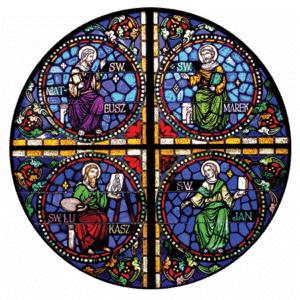 Fougerousse and his students also created the two stained-glass windows flanking the sanctuary, each with an angel depicted within it, as well as two transom windows over the doors to the sacristy, one depicting the intertwined arms of Jesus and Francis, the other featuring a crown, grapes, and wheat as signs of Christ the King and the Eucharist.
Fougerousse and his students also created the two stained-glass windows flanking the sanctuary, each with an angel depicted within it, as well as two transom windows over the doors to the sacristy, one depicting the intertwined arms of Jesus and Francis, the other featuring a crown, grapes, and wheat as signs of Christ the King and the Eucharist.
The ninth stained-glass window, a rose window featuring images of the four Evangelists, is not new. Rather, the window is over a century old and was originally created for a Polish Catholic church in Pittsburgh’s Lawrenceville neighborhood. The window, which was removed from the parish when it closed, sat in storage for many years, until Franciscan’s chapel renovation team discovered it on a trip to the Pittsburgh warehouse where it was housed.
“When we first saw the window, it was in four pieces,” Father Jonathan recalls. “But it was so vibrant with color, we loved the idea of giving life back to the window again.”



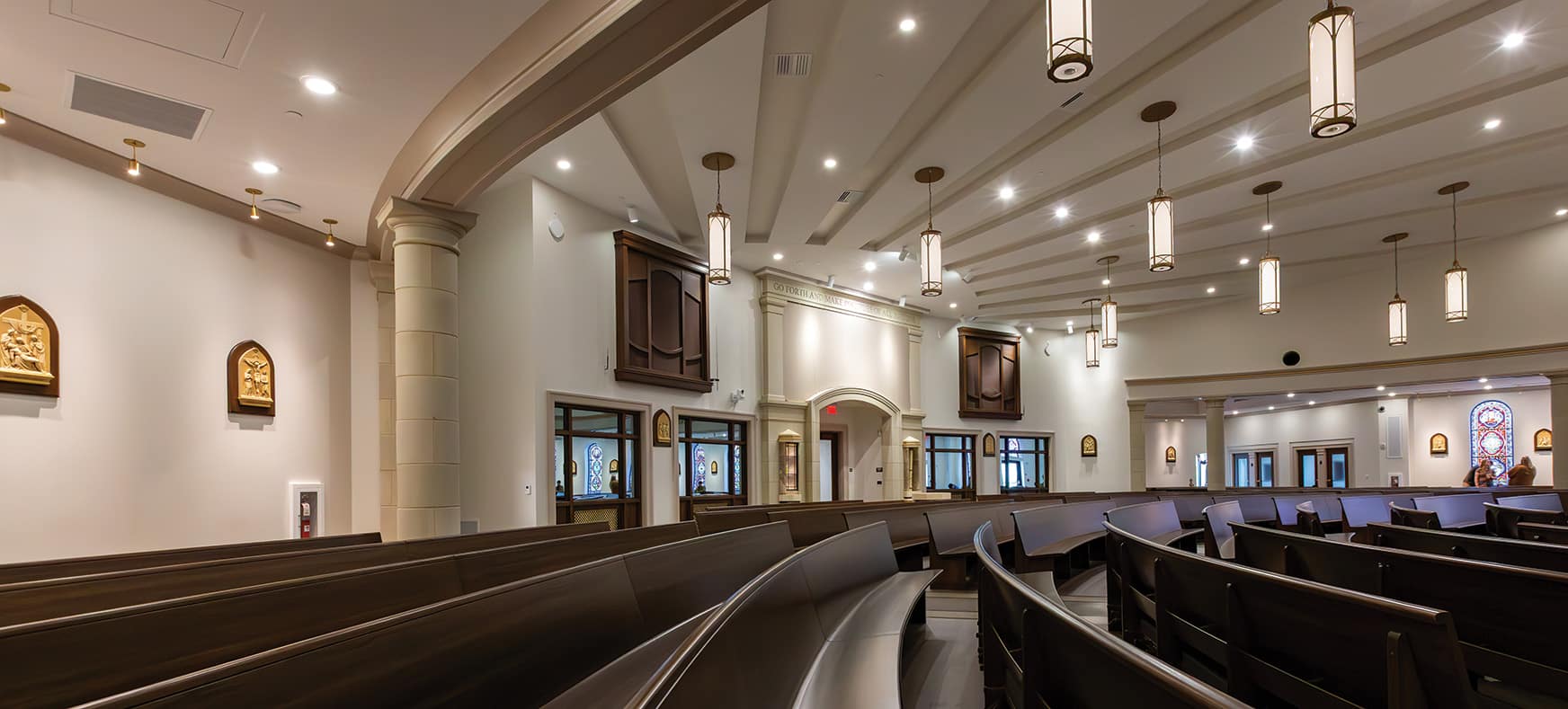
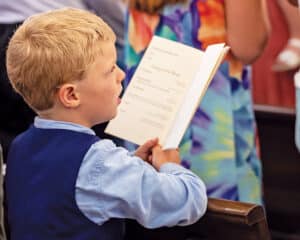 “We are filled with gratitude to our donors, alumni, friars, and friends who made possible the incredibly beautiful renovation and expansion of our beloved Christ the King Chapel,” says
“We are filled with gratitude to our donors, alumni, friars, and friends who made possible the incredibly beautiful renovation and expansion of our beloved Christ the King Chapel,” says 